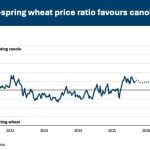The latest batch of government-compiled farm income numbers indicating that incomes are rising brought a familiar disagreement last week over what they mean.
Statistics Canada reported that in 1996, farm operators recorded a 2.6 percent increase in their earnings.
Farm leader Jack Wilkinson denounced that claim as misleading.
He credited the increased income to off-farm earnings and said if depreciation is considered, farm incomes continue to fall.
Money for programs
Wilkinson, president of the Canadian Federation of Agriculture, insisted that governments must start putting money back into farm programs.
Read Also

Farmers urged to be grain-safe this fall
Working around grain bins comes with risk, from farmers falling to drowning in grain: Experts have five tips to help avoid grain-related accidents this harvest.
“Governments must accept their responsibility to ensure a productive environment for primary agricultural producers,” he said in an analysis of the government numbers.
Wilkinson complained that government cuts to safety nets had been “too deep” and it should now start to reinvest. Ottawa also should reconsider the impact of cost recovery fees on farmers who pay the bills.
“Farmers paid a heavy price for the federal government’s balanced budget,” he said. “They should be able to reap some of the benefits of what they’ve given so much to help to achieve.”
The Statistics Canada farm income numbers for the year reported average farm income in 1996 was $38,203 – 52.5 percent of it from off-farm income.
Manitoba the lowest
Alberta farmers had the highest average incomes at $42,049. Manitoba average farm incomes were $12,000 lower and the smallest in the country.
Potato farmers had the highest average incomes while poultry and egg farmer incomes fell 4.6 percent during the year.
Across-the-board, off-farm income increased by 4.4 percent while income from farm sales nudged up 0.7 percent before depreciation.
The CFA noted that to continue the current pace of expansion in farm production and efficiency, farmers have been borrowing to buy new equipment and running farm debt up to record levels.
“The costs of operating a farm increased yearly, by 23 percent between 1992 and 1996,” said the CFA analysis. “What all of those numbers add up to is a steady decline in the income farmers have been able to earn from farming – 26.6 percent since 1988.”
Government officials and agriculture minister Lyle Vanclief have a different take on the same numbers.
He and Wilkinson publicly disagreed during the CFA annual meeting when the minister told delegates farm incomes are rising.














